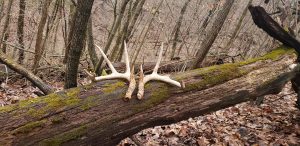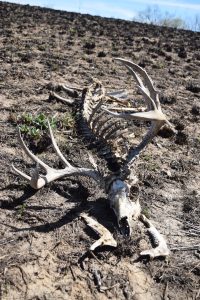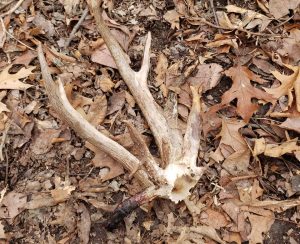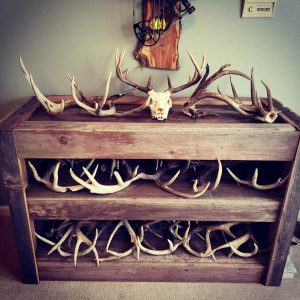Shed Hunting–A Deer Hunter’s Second Favorite Sport
Almost as popular as deer hunting, searching for Whitetail deer antler sheds can be satisfying and provide exercise to boot! Be sure to get permission to shed hunt on property that does not belong to you. There is an Illinois law on the books that prohibits hunting for sheds on others’ property without permission from the landowner.
Bob Robb, in an online article from Grand View Outdoors, provides this information: “Antlers are made up of a honeycombed bone-like tissue. The mounting points on the heads of deer from which the antlers grow are called pedicles. The antlers break off (are shed) from these pedicles. Pedicles appear on a young deer’s forehead during his first year. The next year, he will develop small shafts, and by year three the first “branch” will appear. As the deer matures, the antlers will lengthen and thicken and often develop additional branches. While in the growth phase, the antlers are covered in a soft membrane referred to as “velvet,” a layer of skin that supplies the growing antlers with the nutrients needed to build the bone mass. This velvet contains many substances such as amino acids, minerals, proteins and Growth Factor-1 (a protein hormone similar in molecular structure to insulin).
The antlers will grow rapidly for two to four months. During the summer, higher levels of the male hormone testosterone slow antler growth, and the veins and arteries around the velvet constrict and cut off the blood and nutrient supply to the antlers. The velvet then withers and begins to fall off, a process facilitated by the deer by rubbing his antlers against trees. The whole process is repeated every year for the rest of his life.”

Some suggest that male deer shed their antlers to blend in with females so predators don’t target them as they roam their territories in a diminished state in late winter after the rigors of the rut and breeding during the fall and early winter. However, the more widely accepted reason for antler drop is a buck’s falling testosterone level following the rut which causes a weakening in the tissue and bone at the antler base to the point where the antlers simply fall off.
Whitetail deer can drop their antlers anywhere from late December through early April. The health of the buck is the biggest determining factor in how early or late the antlers come off. Drought, excessive rain, extreme heat or cold, predator presence, injury, human habitat alterations and a host of other factors directly affect deer health and stress.

Here are a few tips for the beginning shed hunter:
1. First and foremost, get permission from the landowner if you are planning to shed hunt on property other than your own. It is not only courteous, it is the law.
2. Be prepared for all types of weather and terrain. Dress for the weather in layers and appropriate footwear. You will likely be traversing ridges and ravines if you plan to shed hunt in the Monroe County bluff lands. Make sure your feet are comfortable and that your shoes offer good traction. Carry a backpack to hold a snack, water, extra clothing, binoculars (more on that later) and, of course, your sheds.
3. Bring binoculars. There is nothing more frustrating than ascending a steep slope in pursuit of a shed that turns out to be a tree branch.

4. Clouds are your friends when shed hunting. Yes, it’s nice to be outside on a sunny day, but a cloudy day makes it so much easier to spot fallen antlers. Hunting in a drizzle may seem counterintuitive, but the rain helps to mat down the leaves making antlers stand out.
5. Don’t start shed hunting too early after the rut, you may push deer out of their refuge areas. This stresses them out and may force them onto properties on which you don’t have permission to hunt, creating the possibility that they will drop their antlers on that property. This can also happen if you spend too much time in one area day after day. Deer are especially vulnerable to stress right after breeding and dealing with winter weather.
6. If you start shed hunting too late in the season, mice may have gotten to the fallen antlers. Rodents can gnaw an antler to a nub in a matter of weeks while gleaning essential minerals from it.
7. The best spots to shed hunt are in bedding areas, known feeding locations (like in a grove of oak trees where acorns are plentiful), or along deer travel corridors. These travel corridors are clearly evident in the woods or grassy areas as they will be trampled flat. Look for areas where deer may have to jump over an obstacle which might jar antlers loose.

Now is a good time to enjoy the outdoors, get some exercise and start your new hobby of shed hunting!
CLIFFTOP, a local non-profit organization, is focused on preserving and protecting area bluff lands.
A version of this article appeared in the February 21, 2020 edition of the Monroe County Independent.
©2020 all content rights reserved Clifftop NFP
Comments are currently closed.
